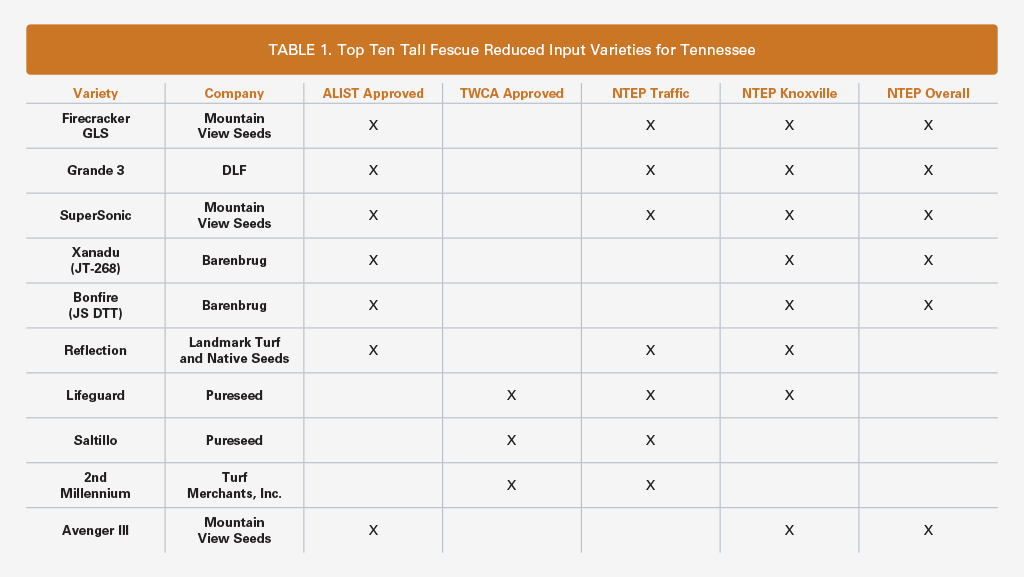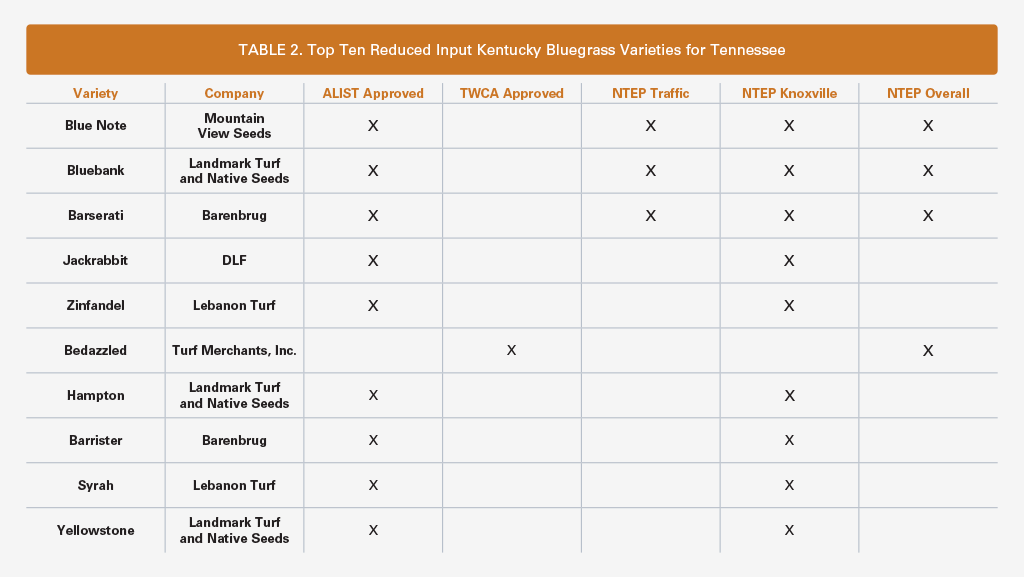
10 minute read
Cover Story
Improving Turfgrass Sustainability with Better Genetics
By Kyley Dickson, Ph.D.
When it comes time to reseed or renovate an area in the fall or spring, selecting the most suitable grass variety can be a challenging task. Over the years, plant breeders and seed companies have made significant advancements in enhancing their grasses through plant breeding. These improvements include developing grasses with resistance or increased tolerance to specific diseases, better drought tolerance, and an enhanced ability to withstand extreme climatic conditions. However, verifying these claims is crucial. To address this, various research programs conduct tests on new turfgrass varieties under different conditions, comparing them with standard grasses that have been used for many years.
Research programs are essential in identifying new varieties of turfgrasses that stand out as premium performers and discovering how much they have improved. For instance, Kentucky 31 tall fescue, which was identified in Kentucky in 1931, is still available for purchase at most stores that sell grass seed today. The improvements in technology have increased efficiency and overall performance of turfgrasses, just like how cars have evolved from 1931 to today. Plant breeders make major improvements every year, with many of these new varieties being more efficient with fewer inputs and more adapted to difficult environments. Breeders look at several variables such as plant density, color, leaf thickness, disease resistance, drought tolerance, and traffic tolerance to improve turfgrasses.

The National Turfgrass Evaluation Program (NTEP) is a renowned turfgrass research program that has gained global recognition. It has expanded to evaluate seventeen turfgrass species across forty U.S. states and six Canadian provinces. The program collects and summarizes data on various aspects of turfgrass, including quality, color, density, resistance to diseases and insects, and tolerance to heat, cold, drought, and traffic. NTEP’s findings are used by plant breeders, researchers, extension personnel, local and state government entities, growers, and consumers worldwide. The program has become the standard for turfgrass evaluation in the United States and many other countries.

The NTEP trials are carried out over a consecutive fiveyear period at various research universities across the nation. The researchers monitor the quality of each variety, recording monthly results. At the end of each year, they publish an updated report on the trials. The NTEP data is a valuable resource that can help determine grass varieties that are ideal for low maintenance, traffic tolerance, and overall quality. This is due to the wide range of trials conducted by the program. The data is freely accessible to everyone on NTEP.org. Additionally, the NTEP has introduced a new search tool that allows users to identify different grasses based on species, location, or variety. You can also scan the QR code provided to visit the NTEP website directly.
It’s important to note that while the data is available online, there are no certifications or approval of varieties from the NTEP. The information solely reflects how well a particular grass variety performed in the trials. Nevertheless, this resource is highly beneficial when selecting turfgrass varieties. Next time you purchase a seed bag, take a moment to examine the tag and review how the grasses fared in the NTEP trials. Opting for a variety that performed well in your area according to NTEP results will likely yield superior results. Keep in mind that certain varieties may thrive better in specific regions of the country compared to others. Therefore, it’s advisable to consider the locations of the tests and select a variety that closely represents your area.
There are organizations that offer approved varieties or certifications. Two such organizations are the Alliance for Low Input Sustainable Turf (A-LIST) and the Turfgrass Water Conservation Alliance (TWCA). Similar to the NTEP, both the A-LIST and TWCA conduct research trials at universities across the U.S. to evaluate grasses. Currently, these trials are limited to cool season grasses.
The Alliance for Low Input Sustainable Turf (A-LIST) is a national non-profit organization that aims to assist turfgrass managers and grass growers in achieving sustainable plant growth. The organization comprises universities and industry companies that work together to test, identify, and promote grass varieties that combine high turf quality with low-input performance. These varieties are designed to reduce water, chemical, and fertility requirements. The A-LIST provides information on certified, highquality turf that is verified through transparent protocols and independently tested. The A-LIST focuses on varieties respond to reduced inputs such as water, fungicides, insecticides, herbicides, and fertility. To become A-LIST approved, grasses must be in the top statistical grouping at multiple locations over multiple years.

The Turfgrass Water Conservation Alliance (TWCA) is a non-profit organization committed to water conservation and dedicated to preserving the ecological benefits of turfgrass in the managed environment. The organization believes that by improving the plant materials available, they can reduce the water needs of the managed environment while preserving the vital ecological services provided by green space. The TWCA provides independent transparent analysis of objective data, which anchors their peer-reviewed qualification process. The TWCA program assesses drought tolerance of grasses using rainout shelters to simulate drought conditions and measure their resilience.

The research funded from these organizations instills confidence that the grasses possess the improved traits claimed by the respective organizations. Both programs indicate their approval by displaying their logos on seed tags located on each bag. Currently, there are only approvals for seed for cool-season grasses. These programs have resulted in greater breeding efforts that has resulted in the traits each of these organizations are focused on. The work these organizations have done to improve areas of breeding that have not always been the highest priority is tremendous. Both organizations are formed from groups of seed companies that saw a need and have funded research to further breeding in each area and decided to make it happen. For a comprehensive list of approved varieties, please refer to each organization’s websites https://a-listturf.org or https://www.tgwca.org, or scan the QR codes.
Using grass varieties that require lower inputs is better for the environment. These varieties are more sustainable because they need less water, or fertilizer, or pesticides to thrive. By reducing the use of these inputs, we can minimize the environmental impact and promote a healthier ecosystem. These new varieties require fewer chemical treatments and less water, making them more environmentally friendly. Additionally, they can help conserve water resources and reduce the need for synthetic fertilizers.
If you think, “It’s great that they have these approvals for low inputs and water reduction, but how did they do in our area?” Well for those who live in Tennessee, table 1 is a top ten list of reduced input of tall fescue varieties and table 2 is for Kentucky bluegrass. These tables show either A-LIST or TWCA varieties that did well in Tennessee’s NTEP and all the NTEP trials overall that grass species overall. There are three varieties of tall fescue and Kentucky bluegrasses that are in bold, these highlighted varieties would be the top three varieties for use in Tennessee due to their superior performance in research trials. The other top ten are great varieties perform well in Tennessee, the bolded varieties simply highlight the top performers according to the criteria used to rank the grasses overall. All the grass varieties in both lists should have superior performance in these conditions and can survive in more stressful conditions than traditional standard varieties. Not all grasses are great in all circumstances, sticking with the car analogy you would not use a small car to try and pull a semi-trailer, as with grasses some are adapted for certain uses better than others. Keep in mind that even the most adapted grasses can still die and do poorly if the conditions for growth become too harsh.TABLE 1


The data from the NTEP is from Knoxville at the University of Tennessee trial site. To explain the table there is an X by each area that a grass was the top statistical category for that area. The columns show if they are A-LIST or TWCA approved. Additionally, there is a column indicating they were in the top statistical performer for the NTEP traffic trial, this indicates that the varieties had superior traffic tolerance good for high use areas. Additionally, the top statistical category for the NTEP trial in Knoxville, this helps to see how these varieties would do in an area with similar growing conditions to Knoxville. The last column is when all the NTEP locations for that trial are taken and averaged, these grasses were in the top performers for the trial overall.
One of the limitations of the National Turfgrass Evaluation Program (NTEP) is that many of the varieties it tests are not commercially available or may never go into commercial production for various reasons. However, this article aims to provide tables of commercially available varieties that can be purchased today. These varieties can help improve management situations where inputs are limited or where you simply want a variety with improved genetics that offers optimum performance. However, locating these improved varieties can be challenging. I have included a list of companies that currently sell these products in the tables. It is important to note that these higher-end products are typically not available at big-box stores; instead, they can be found at landscape supply stores, distributors, or sod farms.
It is important to note that grass varieties that thrive in one region may not perform well in another. Therefore, it is advisable to look at the NTEP data for your specific area. The NTEP provides valuable information about grass varieties that excel in different regions. For instance, certain varieties may flourish in Utah but struggle in Tennessee. By selecting the right variety for your area, you can optimize your turfgrass management and achieve better results.
Grass breeding efforts have significantly contributed to improving sustainability and adaptability. Universities such as Rutgers, Oklahoma State University, University of Georgia at Tifton, Texas A&M University, University of Florida, Mississippi State University, and North Carolina State University, along with seed companies, have made remarkable progress in breeding grass varieties with improved genetics. These varieties listed in the tables are more resistant to pests, diseases, and drought. They require fewer chemical treatments and less water, making them more environmentally friendly. By leveraging these advancements in grass breeding, you can enhance your turfgrass management situation and contribute to a greener and healthier environment. In a world where resources are becoming increasingly scarce, it is crucial to choose grasses that are well-suited to their environment. This article presents an overview of some of the top cool season grasses to consider when making selections in Tennessee. In the southern part of the state, cool season grasses may struggle to thrive, making warm season grasses a more viable option. Tennessee has seen great success with many warm season grasses, including Bermudagrass and Zoysia. The tables are specifically cool season grasses that are two commonly used grasses in Tennessee. The advancements in breeding in the last two decades show some amazing improvements in a short period of time. When renovating or reseeding an area this fall, consider opting for seeds with improved genetics. Doing so will result in better turf quality and contribute to a healthier environment overall. If you are unsure whether to choose cool or warm season grasses, consult with a University of Tennessee County Extension agent for guidance.





